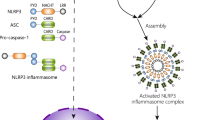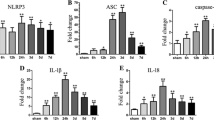Abstract
Inflammation is a crucial factor contributing to secondary brain injury after intracerebral haemorrhage (ICH). NLRP6, a member of nod-like receptors (NLRs) family, has been reported to participate in inflammation and host-defence in multiple diseases. Distinct from the other NLR family members, NLRP6 regulates inflammation in an inflammasome-dependent as well as an inflammasome-independent pathway. However, the role of NLRP6 in regulating signalling pathways during ICH is poorly understood. In the present study, we demonstrated that NLRP6 expression was upregulated after ICH, both in humans and in rats. Subsequently, we developed a rat model of ICH and found that NLRP6 knockdown reduced brain injury, alleviated inflammation, and suppressed autophagy following ICH. Further, results indicated that autophagy involved in NLRP6 mediated inflammation after ICH. Moreover, we found that NLRP6 mediated regulation of autophagy and inflammation was inflammasome-dependent. This study revealed the underlying molecular mechanism of NLRP6 in inflammation and highlights the therapeutic potential of targeting NLRP6 in secondary brain injury after ICH.
Key messages
• NLRP6 was upregulated following ICH in humans and rats.
• NLRP6 knockdown reduced brain injury, alleviated inflammation, and suppressed autophagy following ICH.
• NLRP6 aggravated inflammation after ICH by activating autophagy.
• NLRP6 regulated inflammation and autophagy after ICH by activating inflammasome pathway.






Similar content being viewed by others
References
Qureshi AI, Mendelow AD, Hanley DF (2009) Intracerebral haemorrhage. Lancet 373:1632–1644
Zhou Y, Wang Y, Wang J, Stetler RA, Yang QW (2014) Inflammation in intracerebral hemorrhage: from mechanisms to clinical translation. Prog Neurobiol 115:25–44
Ren H, Kong Y, Liu Z, Zang D, Yang X, Wood K, Li M, Liu Q (2018) Selective NLRP3 (pyrin domain-containing protein 3) inflammasome inhibitor reduces brain injury after intracerebral hemorrhage. Stroke 49:184–192
Sheth KN, Rosand J (2014) Targeting the immune system in intracerebral hemorrhage. JAMA Neurol 71:1083–1084
Próchnicki T, Latz E (2017) Inflammasomes on the crossroads of innate immune recognition and metabolic control. Cell Metab 26:71–93
Latz E, Xiao TS, Stutz A (2013) Activation and regulation of the inflammasomes. Nat Rev Immunol 13:397–411
Sellin ME, Maslowski KM, Maloy KJ, Hardt WD (2015) Inflammasomes of the intestinal epithelium. Trends Immunol 36:442–450
Ma Q, Chen S, Hu Q, Feng H, Zhang JH, Tang J (2014) NLRP3 inflammasome contributes to inflammation after intracerebral hemorrhage. Ann Neurol 75:209–219
Elinav E, Strowig T, Kau AL, Henao-Mejia J, Thaiss CA, Booth CJ, Peaper DR, Bertin J, Eisenbarth SC, Gordon JI, Flavell RA (2011) NLRP6 inflammasome regulates colonic microbial ecology and risk for colitis. Cell 145:745–757
Normand S, Delanoye-Crespin A, Bressenot A, Huot L, Grandjean T, Peyrin-Biroulet L, Lemoine Y, Hot D, Chamaillard M (2011) Nod-like receptor pyrin domain-containing protein 6 (NLRP6) controls epithelial self-renewal and colorectal carcinogenesis upon injury. Proc Natl Acad Sci U S A 108:9601–9606
Wlodarska M, Thaiss CA, Nowarski R, Henao-Mejia J, Zhang JP, Brown EM, Frankel G, Levy M, Katz MN, Philbrick WM, Elinav E, Finlay BB, Flavell RA (2014) NLRP6 inflammasome orchestrates the colonic host-microbial interface by regulating goblet cell mucus secretion. Cell 156:1045–1059
Ghimire L, Paudel S, Jin L, Baral P, Cai S, Jeyaseelan S (2018) NLRP6 negatively regulates pulmonary host defense in Gram-positive bacterial infection through modulating neutrophil recruitment and function. PLoS Pathog 14:1–24
Ydens E, Demon D, Lornet G, de Winter V, Timmerman V, Lamkanfi M, Janssens S (2015) Nlrp6 promotes recovery after peripheral nerve injury independently of inflammasomes. J Neuroinflammation 12:1–14
Lu WL, Zhang L, Song DZ, Yi XW, Xu WZ, Ye L, Huang DM (2019) NLRP6 suppresses the inflammatory response of human periodontal ligament cells by inhibiting NF-κB and ERK signal pathways. Int Endod J 52:999–1009
Grenier JM, Wang L, Manji GA, Huang WJ, al-Garawi A, Kelly R, Carlson A, Merriam S, Lora JM, Briskin M, DiStefano PS, Bertin J (2002) Functional screening of five PYPAF family members identifies PYPAF5 as a novel regulator of NF-κB and caspase-1. FEBS Lett 530:73–78
Hu S, Xi G, Jin H, He Y, Keep RF, Hua Y (2011) Thrombin-induced autophagy: a potential role in intracerebral hemorrhage. Brain Res 18:60–66
Yuan B, Shen H, Lin L, Su T, Zhong L, Yang Z (2017) Autophagy promotes microglia activation through Beclin-1-Atg5 pathway in intracerebral hemorrhage. Mol Neurobiol 54:115–124
Yang Z, Liu B, Zhong L, Shen H, Lin C, Lin L, Zhang N, Yuan B (2015) Toll-like receptor-4-mediated autophagy contributes to microglial activation and inflammatory injury in mouse models of intracerebral haemorrhage. Neuropathol Appl Neurobiol 41:e95–e106
Deinsberger W, Vogel J, Kuschinsky W, Michael Auer L, Böker DK (1996) Experimental intracerebral hemorrhage: description of a double injection model in rats. Neurol Res 18:475–477
He Z, Ostrowski RP, Sun X, Ma Q, Huang B, Zhan Y, Zhang JH (2012) CHOP silencing reduces acute brain injury in the rat model of subarachnoid hemorrhage. Stroke 43:484–490
Yuan Y, Zheng Y, Zhang X, Chen Y, Wu X, Wu J, Shen Z, Jiang L, Wang L, Yang W, Luo J, Qin Z, Hu W, Chen Z (2017) BNIP3L/NIX-mediated mitophagy protects against ischemic brain injury independent of PARK2. Autophagy 13:1754–1766
Duan XC, Wang W, Feng DX, Yin J, Zuo G, Chen DD, Chen ZQ, Li HY, Wang Z, Chen G (2017) Roles of autophagy and endoplasmic reticulum stress in intracerebral hemorrhage-induced secondary brain injury in rats. CNS Neurosci Ther 23:554–566
Wu B, Ma Q, Khatibi N, Chen W, Sozen T, Cheng O, Tang J (2010) Ac-YVAD-CMK decreases blood-brain barrier degradation by inhibiting Caspase-1 activation of interleukin-1β in intracerebral hemorrhage mouse model. Transl Stroke Res 1:57–64
Chen J, Li Y, Wang L, Zhang Z, Lu D, Lu M, Chopp M (2001) Therapeutic benefit of intracerebral transplantation of bone marrow stromal cells after cerebral ischemia in rats. Stroke 32:1005–1011
Jiang N, Tan J, Meng C et al (2019) TOM7 silencing exacerbates focal cerebral ischemia injury in rat by targeting PINK1/Beclin1-mediated autophagy. Behav Brain Res 360:113–119
Sun Y, Dai M, Wang Y, Wang W, Sun Q, Yang GY, Bian L (2011) Neuroprotection and sensorimotor functional improvement by curcumin after intracerebral hemorrhage in mice. J Neurotrauma 28:2513–2521
Urday S, Kimberly WT, Beslow LA, Vortmeyer AO, Selim MH, Rosand J, Simard JM, Sheth KN (2015) Targeting secondary injury in intracerebral haemorrhage—perihaematomal oedema. Nat Rev Neurol 11:111–112
Levy M, Shapiro H, Thaiss CA, Elinav E (2017) NLRP6: a multifaceted innate immune sensor. Trends Immunol 38:248–260
Liu W, Liu J, Wang W, Wang Y, Ouyang X (2018) NLRP6 induces pyroptosis by activation of caspase-1 in gingival fibroblasts. J Dent Res 97:1391–1398
Hara H, Seregin SS, Yang D, Fukase K, Chamaillard M, Alnemri ES, Inohara N, Chen GY, Núñez G (2018) The NLRP6 inflammasome recognizes lipoteichoic acid and regulates gram-positive pathogen infection. Cell 175:1–14
Xie Y, Li YJ, Lei B, Kernagis D, Liu WW, Bennett ER, Venkatraman T, Lascola CD, Laskowitz DT, Warner DS, James ML (2019) Sex differences in gene and protein expression after intracerebral hemorrhage in mice. Transl Stroke Res 10:231–239
James ML, Langefeld CD, Sekar P, Moomaw CJ, Elkind MSV, Worrall BB, Sheth KN, Martini SR, Osborne J, Woo D, ERICH Investigators (2017) Assessment of the interaction of age and sex on 90-day outcome after intracerebral hemorrhage. Neurology 89:1011–1019
Radulovic K, Normand S, Rehman A, Delanoye-Crespin A, Chatagnon J, Delacre M, Waldschmitt N, Poulin LF, Iovanna J, Ryffel B, Rosenstiel P, Chamaillard M (2018) A dietary flavone confers communicable protection against colitis through NLRP6 signaling independently of inflammasome activation. Mucosal Immunol 11:811–819
Chen H, Li Y, Gu J, Yin L, Bian F, Su L, Hong Y, Deng Y, Chi W (2018) TLR4-MyD88 pathway promotes the imbalanced activation of NLRP3/NLRP6 via caspase-8 stimulation after alkali burn injury. Exp Eye Res 176:59–68
Lin Y, Luo Z (2017) NLRP6 facilitates the interaction between TAB2/3 and TRIM38 in rheumatoid arthritis fibroblast-like synoviocytes. FEBS Lett 591:1141–1149
Birchenough GM, Nyström EE, Johansson ME, Hansson GC (2016) A sentinel goblet cell guards the colonic crypt by triggering Nlrp6-dependent Muc2 secretion. Science 352:1535–1542
Volk JK, Nyström EEL, van der Post S, Abad BM, Schroeder BO, Johansson Å, Svensson F, Jäverfelt S, Johansson MEV, Hansson GC, Birchenough GMH (2019) The Nlrp6 inflammasome is not required for baseline colonic inner mucus layer formation or function. J Exp Med 216:2602–2618
Mamantopoulos M, Ronchi F, Van Hauwermeiren F et al (2017) Nlrp6- and ASC-dependent inflammasomes do not shape the commensal gut microbiota composition. Immunity 47:339–348.e4
Wang PF, Li ZG, Zhang Y, Ju XH, Liu XW, Zhou AM, Chen J (2017) NLRP6 inflammasome ameliorates brain injury after intracerebral hemorrhage. Front Cell Neurosci 11:1–9
EI-Brolosy MA, Stainier DYR (2017) Genetic compensation: a phenomenon in search of mechanisms. PLoS Genet 13:1–17
He Y, Wan S, Hua Y, Keep RF, Xi G (2008) Autophagy after experimental intracerebral hemorrhage. J Cereb Blood Flow Metab 28:897–905
Yu A, Zhang T, Zhong W, Duan H, Wang S, Ye P, Wang J, Zhong S, Yang Z (2017) miRNA-144 induces microglial autophagy and inflammation following intracerebral hemorrhage. Immunol Lett 182:18–23
Shi H, Wang J, Wang J, Huang Z, Yang Z (2018) IL-17A induces autophagy and promotes microglial neuroinflammation through ATG5 and ATG7 in intracerebral hemorrhage. J Neuroimmunol 323:143–151
Shen X, Ma L, Dong W, Wu Q, Gao Y, Luo C, Zhang M, Chen X, Tao L (2016) Autophagy regulates intracerebral hemorrhage induced neural damage via apoptosis and NF-κB pathway. Neurochem Int 96:100–112
Scarlatti F, Maffei R, Beau I, Codogno P, Ghidoni R (2008) Role of non-canonical Beclin 1-independent autophagy in cell death induced by resveratrol in human breast cancer cells. Cell Death Differ 15:1318–1329
Acknowledgements
The authors are grateful to Prof. Jingxian Wu and Prof. Lingyu Li for technical assistance.
Funding
National Key Research and Development Program of China (No. 2016YFE0203900), National Natural Science Foundation of China (No. 81971217), and Natural Science Foundation of Chongqing Science and Technology Committee, China (No. cstc2015jcyjBX0144) supported this work.
Author information
Authors and Affiliations
Corresponding author
Ethics declarations
All human studies have been approved by Ethics Committee of Children’s Hospital Affiliated to Chongqing Medical University. Prior written informed consent was obtained from participants or their legal representatives (in case of diseased). Animal experimentation conforms to protocols approved by the Institutional Ethics Committee of Chongqing Medical University.
Conflict of interest
The authors declare that they have no conflict of interest.
Additional information
Publisher’s note
Springer Nature remains neutral with regard to jurisdictional claims in published maps and institutional affiliations.
Electronic supplementary material
ESM 1
(DOCX 5118 kb)
Rights and permissions
About this article
Cite this article
Xiao, H., Chen, H., Jiang, R. et al. NLRP6 contributes to inflammation and brain injury following intracerebral haemorrhage by activating autophagy. J Mol Med 98, 1319–1331 (2020). https://doi.org/10.1007/s00109-020-01962-3
Received:
Revised:
Accepted:
Published:
Issue Date:
DOI: https://doi.org/10.1007/s00109-020-01962-3




